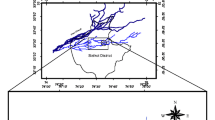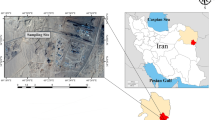Abstract
Contaminant accumulation analysis is important in the study of sentinels. This research determined cadmium accumulation and bioconcentration factors of whole organism, liver, kidney, ovary and testis of Fejervarya limnocharis exposed to different environmental cadmium levels. Frogs from contaminated sites had significantly higher hepatic (1.939 mg/kg), renal (7.253 mg/kg) and testicular (1.462 mg/kg) cadmium than those from the reference sites (0.205, 0.783 and 0.379 mg/kg, respectively). Cadmium accumulation was the highest during the late dry and early rainy seasons. If this species is used as a sentinel for cadmium accumulation, the utilization of its whole organism, liver, kidney and testis is appropriate.


Similar content being viewed by others
References
AmphibiaWeb (2008) Fejervarya limnocharis, alpine cricket frog. Available via DIALOG. http://amphibiaweb.org. Accessed 6 Jan 2008
Bervoets L, Blust R (2003) Metal concentrations in water, sediment and gudgeon (Gobio gobio) from a pollution gradient: relationship with fish condition factor. Environ Pollut 126:9–19. doi:10.1016/S0269-7491(03)00173-8
Bervoets L, Blust R, Verheyen R (2001) Accumulation of metals in tissues of three-spined stickleback (Gasterousteus aculeatus) from natural fresh waters. Ecotoxicol Environ Saf 48:117–127. doi:10.1006/eesa.2000.2010
Burger J, Campbell KR, Murray S, Campbell TS, Gaines KF, Jeitner C, Shukla T, Burke S, Gochfeld M (2007) Metal levels in blood, muscle and liver of water snakes (Nerodia spp) from New Jersey, Tennessee and South Carolina. Sci Total Environ 373:56–563. doi:10.1016/j.scitotenv.2006.06.018
Flament S, Kuntz S, Chesnel A, Grillier-Vuissoz I, Tankozic C, Penrad-Mobayed M, Auque G, Shirali P, Schroeder H, Chardard D (2003) Effect of cadmium on gonadogenesis and metamorphosis in Pleurodeles waltl (urodele amphibian). Aquat Toxicol 64:143–153. doi:10.1016/S0166-445X(03)00042-0
Foran CM, Peterson BN, Benson WH (2002) Influence of parental and developmental cadmium exposure on endocrine and reproductive function in Japanese medaka (Oryzias latipes). Comp Biochem Physiol C 133:345–354
Francis PC, Birge WJ, Black JA (1984) Effects of cadmium-enriched sediment on fish and amphibian embryo-larval stages. Ecotoxicol Environ Saf 8:378–387. doi:10.1016/0147-6513(84)90006-X
IUCN (International Union for Conservation of Nature), Conservation International and NatureServe (2006) Global amphibian assessment. Available via www.globalamphibians.org. Accessed 6 Jan 2008
Lee IP (1983) Effects of environmental metals on male reproduction. In: Clarkson TW, Nordberg GF, Sager PR (eds) Reproductive and developmental toxicity of metals. Plenum Press, New York, pp 253–278
Loumbourdis NS, Vogiatzis AK (2002) Impact of cadmium on liver pigmentary system of the frog Rana ridibunda. Ecotoxicol Environ Saf 53:52–58. doi:10.1006/eesa.2002.2153
Loumbourdis NS, Wray D (1998) Heavy metal concentration in the frog Rana ridibunda from a small river of Macedonia, Northern Greece. Environ Int 24:427–431. doi:10.1016/S0160-4120(98)00021-X
Loumbourdis NS, Kostaropoulos I, Theodoropoulou B, Kalmanti D (2007) Heavy metal accumulation and metallothionein concentration in the frog Rana ridibunda after exposure to chromium or a mixture of chromium and cadmium. Environ Pollut 145:787–792. doi:10.1016/j.envpol.2006.05.011
Olsvik PA, Gundersen P, Andersen RA, Zachariassen KE (2000) Metal accumulation and metallothionein in two populations of brown trout, Salmo trutta, exposed to different natural water environments during a run-off episode. Aquat Toxicol 50:301–316. doi:10.1016/S0166-445X(00)00094-1
Pérez-Coll CS, Herkovits J, Fridman O, Daniel P, D’Eramo JL (1997) Metallothionein and cadmium uptake by the liver in Bufo arenarum. Environ Pollut 97:311–315. doi:10.1016/S0269-7491(97)00071-7
Rie MT (2000) Assessment of the effects of groundwater pollution on a sentinel species, Chrysemys picta, on Cape Cod, MA: tissue contaminant levels and hepatic and reproductive bioindicators. Department of Biology, Boston University, Boston
Simmons RW, Pongsakul P, Saiyasitpanich D, Klinphoklap S (2005) Elevated levels of cadmium and zinc in paddy soils and elevated levels of cadmium in rice grain downstream of a zinc mineralized area in Thailand: implications for public health. Environ Geochem Health 27:501–511. doi:10.1007/s10653-005-7857-z
Zug GR, Vitt LJ, Caldwell JP (2001) Herpetology an introductory biology of amphibians and reptiles, 2nd edn. Academic Press, San Diego
Acknowledgments
This research is part of a graduate research project titled “Using the Rice Frog (Fejervarya limnocharis) as Sentinel Species for Cadmium Contamination in Tak Province, Thailand”. Financial support of this work was obtained from the National Center of Excellence for Environmental and Hazardous Waste Management (NCE-EHWM), the 90th Anniversary of Chulalongkorn University Fund and a new staff development grant (Ratchadaphiseksomphot Endowment Fund), and the MUA-TRF research grant (MRG4980120) to NK. An educational grant from the Malaysian Ministry of Higher Education to MSO is fully acknowledged. Additional support from NIH Fogarty ITREOH, D43 TW007849.
Author information
Authors and Affiliations
Corresponding author
Rights and permissions
About this article
Cite this article
Othman, M.S., Khonsue, W., Kitana, J. et al. Cadmium Accumulation in Two Populations of Rice Frogs (Fejervarya limnocharis) Naturally Exposed to Different Environmental Cadmium Levels. Bull Environ Contam Toxicol 83, 703–707 (2009). https://doi.org/10.1007/s00128-009-9845-y
Received:
Accepted:
Published:
Issue Date:
DOI: https://doi.org/10.1007/s00128-009-9845-y




